|
|
|
|
|
JORDAN
Volunteering On Vacation
Proves Very Gratifying
Photos by Tim Boxer
OLUNTOURISM is getting a big push in
various parts of the world. My trip to Amman was a vacation
that involved volunteer service. I assure you it was an
extremely satisfying experience, affording me a deeper
connection to the Hashemite Kingdom of Jordan.
I visited the
Al-Hussein Society
Habilitation/Rehabilitation of the Physically Challenged
on
Al Raydaneh St. where 97 children with physical disabilities
are taught to become somewhat independent in order to enjoy
a normal life.
I watched Aya,7, who has paralysis of the
legs, as she learned to stand with the help of her trainer,
Fuad.
Executive director Annie Medzhagopian Abu
Hanna enlisted me to guide a 10-year-old in a wheelchair to
the computer room. I assisted as she struggled to manipulate
the keyboard to color some pictures. It was heartbreaking to
see children in various stages of disability, but
heartwarming to be able to help them cope with lifeís
hardships.
Some of the older students are able to make
various crafts. Their products are for sale in the Kenz shop
where youíll see theater costumes, wooden furniture, toy
boxes, book holders, table cloths and Ramadan and Christmas
creations.
Princess Majda Raad, a member of the board,
is enthusiastic about tourists coming to volunteer. Princess
Majda is married to Prince Raad, a cousin of King Abdullah
II.
"Tourists leave enriched by the experience,"
Princess Majda said. "And our children are exposed to
different cultures and languages, so they donít live in a
cocoon."
There are 500,000 people with disabilities
in the country. Al-Hussein Society is making a difference.
After the children leave this center, they go on to the
public schools with renewed confidence, ultimately to take a
productive place in society.
To volunteer at the Al-Hussein Society
contact Annie at
ahsrehab@wanadoo.jo, phone
+962-6-5817598 or write her at P.O.Box 5102, Amman 11183,
Jordan.
|
|
Back to Top
|
|
|
|
|
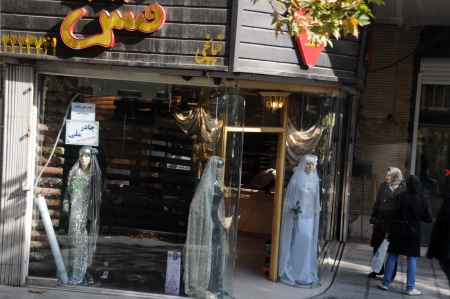
Bridal shop
|
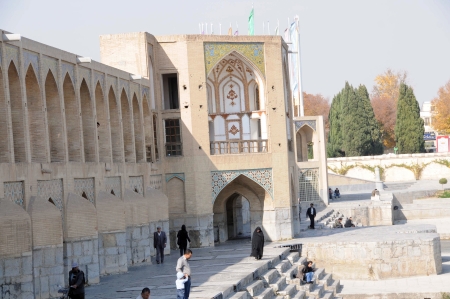
Khaju Bridge |
IRAN
Isfahanís Historic Culture
Intrigues
Every Visitor
Photos by Tim Boxer
SFAHAN is one of the most intriguing
destinations on earth. On a weeklong trip to Iran last fall
I explored Tehran, which has its own charm as a thriving
metropolis; Kish Island, a very attractive resort
playground; Shiraz, with its historic Persepolis ruins, and
romantic Isfahan, rich with architecture, culture and
beauty.
Wherever you walk in Isfahan, one of the
oldest cities in the country, you take a step into history.
Stroll across Khaju, reputedly the most beautiful bridge in
the world. There used to be a temporary palace in the middle
of the bridge, which allowed Shah Abbas II, who built the
bridge in 1650, to sit outside and enjoy the view. No
traffic allowed; itís strictly for people on foot who take
the time to revel in natureís wonders. At times someone
would lean against the stone walls of the promenade and
vocalize a cappella, which always draws an appreciative
audience.
Then thereís the
Sio Se Bridge with its 33
arches, the longest bridge in town. Itís one of several
bridges that span the waters of Zayandeh Rood ("life giving
river") in the middle of town. Built in 1602 during the
reign of Shah Abbas I.
"Tourism has forced
many dictators to change
their behavior."
Mayor of Isfahan |
From the city center cross the Sio Se and
enter Julfa, the Armenian Quarter. There are 10,000
Armenians in Isfahan, and 13 churches.
Vank Cathedral, built
between 1606 and 1655, looks pedestrian, but once you enter
youíll be astonished at the beautiful artwork.
The cathedral is not used for worship as
much as for ceremonial rites. Nearby is the library
containing 20,000 books and the museum, which you should not
miss. I was moved by the huge showcase of books, telegrams
and cables testifying to the 1915 genocide by the Ottoman
Turks when 1.5 million Armenians perished.
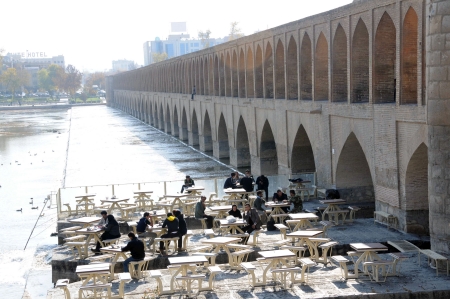
Sio Se Bridge |
Look through the microscope at a strand of
female hair and marvel at sentence written on it. In 1974
Vahram Hakopian took a filament of hair from a woman, 18-20
years old, and wrote a line of biblical verse on it using a
diamond studded pen. Itís a remarkable achievement.
Chehel Sotun Palace (the Palace of Forty
Columns) has 20 pillars which, reflected in the pool look
like 40 columns. Located in the midst of a large garden, the
palace has a large Throne Room where Shah Abbas I held
receptions and entertained his guests on state occasions.
Today itís a museum exhibiting carpets, coins, armor and
porcelain plus magnificent Persian paintings on the walls.
In the environs of the city you may notice
the imposing pigeon towers. Usually built of mud brick, no
two towers are alike. They housed pigeons whose guano was
used by the farmers as fertilizer to produce highly prized
melons.
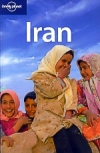 Resources Resources
Lonely Planet Iran contains everything you
need to know about the country youíre planning to tour.
Refer to the book constantly as you visit the exotic sites,
exciting museums and ancient landmarks to learn what youíre
seeing. The information is extensive, profound, and
dispensed in a very friendly manner as youíd expect from
Lonely Planet, soft cover, 452 pages, $25.99
Amazon.com Price $17.15 |
I attended a reception by the mayor of
Isfahan, Dr. M. Saghaeian Nejad, at the utterly stunning
Abbasi Hotel. If youíre not staying here, at least visit.
Youíll find the buildings magnificent and the gardens
exquisite.
The mayor lamented the current atmosphere in
which "the mass media has made many people afraid to travel
to Iran." He extolled the virtues of tourism and held out
hope that the future can be bright.
"Tourism has forced many dictators to change
their behavior," he said.
|
|
|
|
Back to Top
|
|
|
|
|
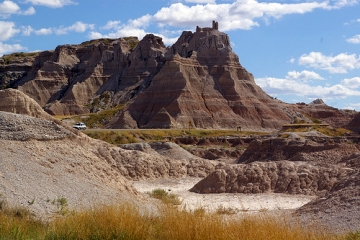
Shadowy buttes and gullies
|
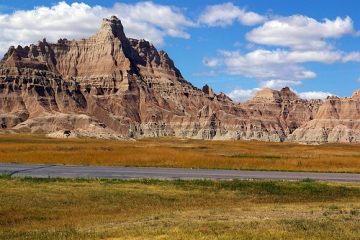
Eroding spires of the wall |
SOUTH DAKOTA
Creepy Yet Enticing,
Welcome To The Badlands
Photos by David Boxer
HE Badlands,
half a million years in the making and a national monument
since 1939, erupts from the earth in jagged formation. Every
year a million visitors come to South Dakota to marvel at
the "fantastic pinnacles and tortuous gullies" as the
National Geographic sees it.
The wall ó a barrenness of spikes and
crevices ó casts an eerie feeling on us all, even the
Indians who came upon this unforgiving landscape, which the
Sioux called Mako Sika, "land bad."
The Badlands National Park, 75 miles east of
Rapid City, is accessible all year. Your first stop should
be the Ben Reifel Visitor Center
where park rangers will
orient you to the areaís history and geology with a very
interesting film.
Nearby is the rustic
Cedar Pass Lodge (605-433-5460), open April-October. The 24 cabins, with
knotty pine interior and no TV or phone, guarantee a deeper
affinity with the environment you came to enjoy. The
restaurant is known for its signature Sioux Indian tacos
with fry bread and seasoned buffalo meat.
|
|
|
|
Back to Top
|
 |
|
Travel Guides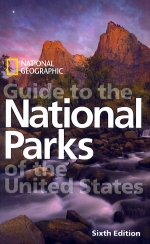
The National Geographic Guide to the
National Parks is a superb reference to Americaís
wilderness, replete with outstanding color maps and
beautiful illustrations as only the National Geographic can
create. Before you go, check out your destination in this
very informative guide. The book is divide the country into
seven sections, covering the East with descriptions of the
Everglades, Congaree, Great Smoky Mountains; The Southwest,
covering Big Bend, Carlsbad Caverns; the Colorado Plateau
with the Petrified Forest, Grand Canyon, Mesa Verde, etc.;
Pacific Southwest with Channel Islands, Death Valley among
other sites; Pacific Northwest with Crater Lake and Redwood
among others; Rocky Mountains with Grand Teton, Badlands,
Great Sand Dunes, etc.; and Alaska with Denali, Glacier Bay
and Kenai Fjords and more. We found this book indispensible.
National Geographic Society, soft cover, 480 pages,
$26
Amazon.com Price: $17.16
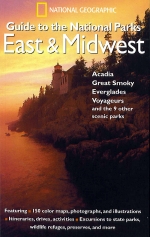 The National Geographic Guide to the
National Parks East & Midwest
focuses your scope to 13
destinations. If youíre headed to Acadia in Maine, Biscayne,
Everglades or Dry Tortugas in Florida, Congaree in South
Carolina, Cuyahoga Valley in Ohio, Great Smoky Mountains in
North Carolina, Hot Springs in Arkansas, Isle Royale in
Michigan, Mammoth Cave in Kentucky, Shenandoah in Western
Virginia, the Voyageurs in Minnesota or the Virgin Islands,
take this book with you. Youíll be well prepared to
encounter the majestic beauty of the American landscape.
National Geographic Society, soft cover, 351 pages,
$22
Amazon.com Price: $19.80 The National Geographic Guide to the
National Parks East & Midwest
focuses your scope to 13
destinations. If youíre headed to Acadia in Maine, Biscayne,
Everglades or Dry Tortugas in Florida, Congaree in South
Carolina, Cuyahoga Valley in Ohio, Great Smoky Mountains in
North Carolina, Hot Springs in Arkansas, Isle Royale in
Michigan, Mammoth Cave in Kentucky, Shenandoah in Western
Virginia, the Voyageurs in Minnesota or the Virgin Islands,
take this book with you. Youíll be well prepared to
encounter the majestic beauty of the American landscape.
National Geographic Society, soft cover, 351 pages,
$22
Amazon.com Price: $19.80
The National Parks
is a stupendous coffee
table edition brimming with spectacular photographs. Itís
based on the 12-hour PBS history of our national parks,
written and produced by Dayton Duncan and directed and
co-produced by the multiple prizewinner Ken Burns. This
magnificent volume serves as a great introduction to the
parks system and the amazing treasures that await every
visitor. It documents the beginnings of each national park
and why itís of utmost importance to preserve its pristine
beauty as a legacy to future generations. Alfred A. Knopf,
403 pages, 440 color and B&W illustrations, removable map,
$50.
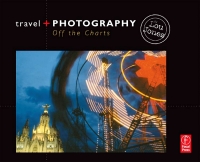 Travel + Photography will guide you how to
travel with a camera. Boston-based fine art photographer Lou
Jones, whose clients include National Geographic and IBM,
solves unique problems that arise with lighting and language
barriers. What kind of lenses should you take on the road,
what kind of filters, do you need a tripod, how to use flash
and bounce light, and many other questions are answered. You
can learn much just by studying the beautiful images Jones
exhibits in the book. Focal Press, softcover, 180 pages,
Amazon.com Price: $29.95 Travel + Photography will guide you how to
travel with a camera. Boston-based fine art photographer Lou
Jones, whose clients include National Geographic and IBM,
solves unique problems that arise with lighting and language
barriers. What kind of lenses should you take on the road,
what kind of filters, do you need a tripod, how to use flash
and bounce light, and many other questions are answered. You
can learn much just by studying the beautiful images Jones
exhibits in the book. Focal Press, softcover, 180 pages,
Amazon.com Price: $29.95
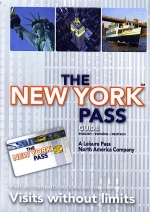 The
New York Pass
guidebook contains a
plastic card that authorizes you entry to more than 55
attractions free of charge. At some of the more popular
places you can even skip the line and gain instant entry.
The booklet consists of 171 very descriptive pages, with
maps, of all the attractions, plus instructions to obtain
discounts on sightseeing tours, restaurants, theaters and
department stores. One day adult pass is $75, child pass is
$55. Also available are passes for 2, 3 and 7 days. More
information and to order, visit
www.newyorkpass.com. The
New York Pass
guidebook contains a
plastic card that authorizes you entry to more than 55
attractions free of charge. At some of the more popular
places you can even skip the line and gain instant entry.
The booklet consists of 171 very descriptive pages, with
maps, of all the attractions, plus instructions to obtain
discounts on sightseeing tours, restaurants, theaters and
department stores. One day adult pass is $75, child pass is
$55. Also available are passes for 2, 3 and 7 days. More
information and to order, visit
www.newyorkpass.com.
|
|
|
|
|
|
|